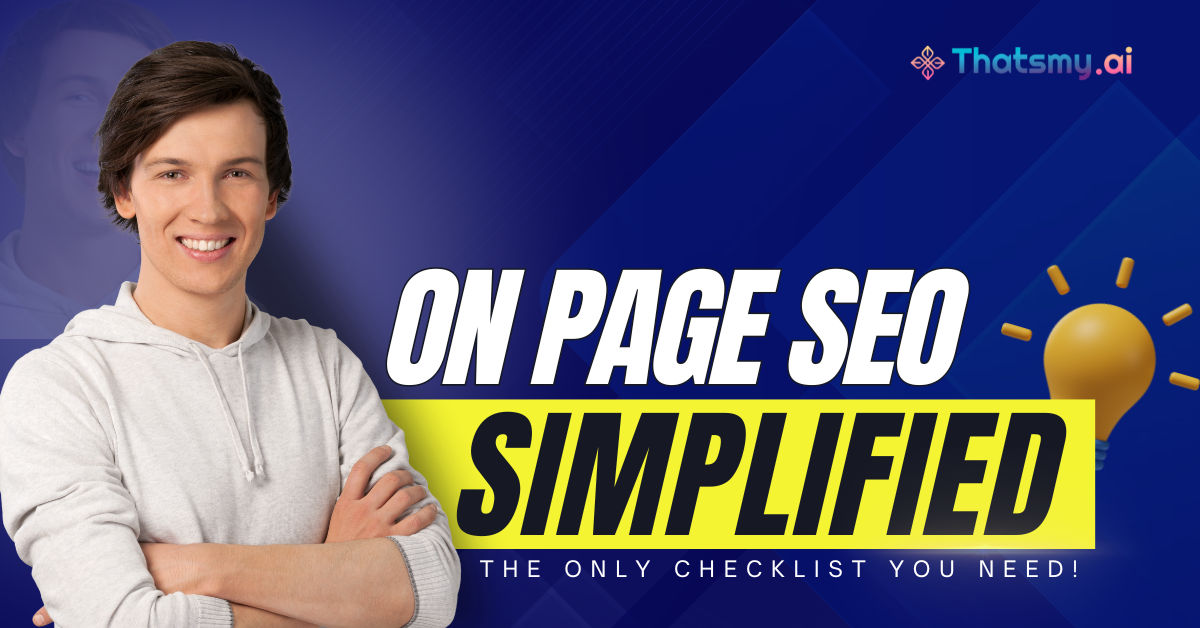
Are you struggling to get your website noticed despite putting in countless hours of work?
One common issue is not optimizing your on-page SEO.
On-page SEO involves optimizing individual web pages to rank higher and earn more relevant traffic in search engines. It's about making sure your content is both useful to users and easy for search engines to understand.
In this blog, we’ll explore every aspect of on-page SEO, breaking down the strategies that can help significantly improve your site's visibility and user experience.
On-page SEO refers to the practice of optimizing elements within your website to improve its search engine rankings.
Unlike off-page SEO, which involves external factors like backlinks, on-page SEO focuses on factors you can control directly. These include content quality, keyword optimization, meta tags, URL structure, and more.
High-quality, relevant content is the cornerstone of on-page SEO. Here’s how to ensure your content is up to par:
Identify primary and secondary keywords for your content. Use tools like Ahrefs, MozPro or SemRush to find relevant keywords with high search volumes and low competition.
Longer content generally performs better in search engines. Aim for comprehensive articles that thoroughly cover the topic.
Write in a clear, concise manner. Use short paragraphs, bullet points, and subheadings to make your content easy to read.
Create content that is interesting and engaging. Use images, videos, infographics, and other multimedia elements to keep readers engaged.
You can leverage the following AI SEO writing tools for best results–
Scalenut - Generate and optimize content tailored for SEO, get keyword recommendations and content structure suggestions. It's perfect for creating high-ranking articles efficiently.
Ink - Get real-time suggestions to improve readability and keyword usage. It's ideal for crafting content that ranks well on search engines.
Rankify - Streamlines your SEO efforts with AI-powered content optimization, focusing on keyword integration and content quality. It's a great tool for ensuring your content meets SEO best practices.
Title tags and meta descriptions are essential for on-page SEO. They help search engines understand the content of your pages and attract users to click on your links.
Title Tags:
Keep your title tags between 50-60 characters.
Include your primary keyword at the beginning of the title.
Use Title Case, capitalizing major words except for "of", "to", etc.
Try following a standard format like “{Page Title} | {Site Name}”
Use the brand name at the end
Consider including location terms
Ensure your title accurately reflects the content of the page.
Meta Descriptions:
Aim for 150-160 characters (including space).
Write a compelling description and make it actionable.
Naturally integrate your primary keyword.
Avoid plagiarism
A clean and descriptive URL structure is important for both users and search engines.
Use descriptive words that reflect the content of the page.
Include primary keywords in the URL.
Use hyphens to separate words in URLs (e.g., www.example.com/best-chocolate-cake-recipe).
Header tags (H1, H2, H3, etc.) help organize your content and make it easier for readers to navigate. They also provide context to search engines.
H1 Tag: Use one H1 tag per page, typically as the main title of the content. It should include the primary keyword.
Subheadings (H2, H3, etc.): Use subheadings to break up your content into sections. Include secondary keywords where appropriate.
Images can enhance your content, but they also need to be optimized for SEO.
Alt Text: Provide descriptive alt text for each image, including relevant keywords.
File Names: Use descriptive file names with keywords (e.g., chocolate-cake.jpg).
Compression: Compress images to reduce file size and improve page load speed.
Internal links help search engines understand the structure of your website and establish a hierarchy of importance.
Relevance: Link to relevant pages within your site.
Anchor Text: Use descriptive anchor text that includes keywords.
Hierarchy: Ensure your most important pages are easily accessible through internal links.
With more users accessing the web via mobile devices, mobile optimization is crucial.
Responsive Design: Ensure your website is responsive and works well on all devices.
Page Speed: Optimize your site for fast loading times on mobile devices.
User Experience: Make sure buttons and links are easily clickable on mobile screens.
A positive user experience can indirectly boost your SEO by reducing bounce rates and increasing dwell time.
Navigation: Make sure your site is easy to navigate.
Design: Use a clean, visually appealing design.
Accessibility: Ensure your site is accessible to all users, including those with disabilities.
Regularly updating your content can signal to search engines that your site is active and relevant.
Updated Content: Update old posts with new information and recent data.
Repurposing: Turn old content into new formats, like infographics or videos.
Consistency: Aim for a consistent posting schedule.
On-page SEO is a fundamental aspect of your overall SEO strategy. By optimizing your content, meta tags, URL structure, and more, you can significantly improve your site's visibility and user experience.
Remember, high-quality, relevant content remains the cornerstone of on-page SEO.
Be sure to check out the best AI SEO tools that can make you 10X faster with best results!
Technical SEO Essentials: Optimize Like a Pro to Get Higher Ranking
Master Off-Page SEO: Best Tactics for Building Authority & Driving Traffic
Local SEO Hacks: Skyrocketing Your Website Traffic Growth
SEO Metrics That Matter: Measure, Optimize & Grow Your Traffic
Sign up to gain AI-driven insights and tools that set you apart from the crowd. Become the leader you’re meant to be.
Start My AI Journey